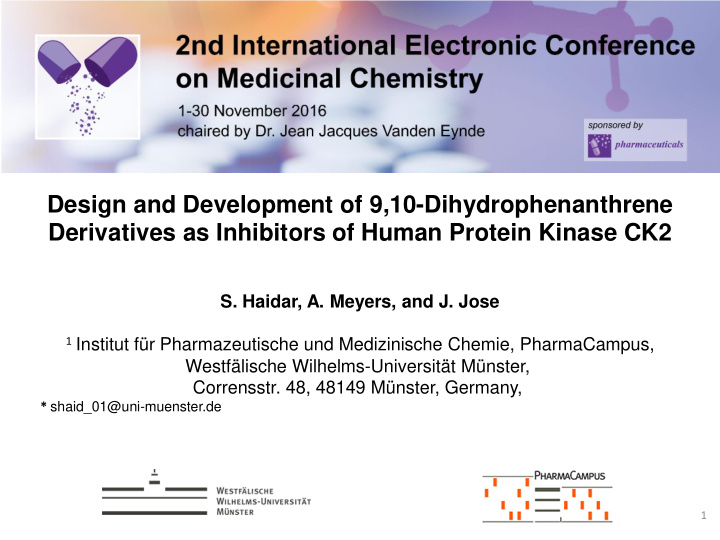



Design and Development of 9,10-Dihydrophenanthrene Derivatives as Inhibitors of Human Protein Kinase CK2 S. Haidar, A. Meyers, and J. Jose 1 Institut für Pharmazeutische und Medizinische Chemie, PharmaCampus, Westfälische Wilhelms-Universität Münster, Corrensstr. 48, 48149 Münster, Germany, * shaid_01@uni-muenster.de 1
Design and Development of 9,10-Dihydrophenanthrene Derivatives as Inhibitors of Human Protein Kinase CK2 Graphical Abstract 2
Abstract: Protein kinase CK2 is an emerging target for the therapeutic intervention in human diseases, particularly in cancer. Inhibitors of this enzyme are currently in clinical trials, indicating the druggability of human CK2. Here we report on the design of several derivatives of 9,10-Dihydrophenanthrene with di-substituted functional groups, using a molecular modeling approach. The inhibitory activity of the synthesized compounds towards CK2 was tested using a capillary electrophoresis in-vitro approach. Furthermore, breast cancer cells (MCF-7) were treated with the designed compounds and cell viability was determined using the MTT assay. Molecular modeling studies were performed using MOE software to understand the binding affinities of the designed compounds. Keywords: CK2, Cancer, Modeling, Dihydrophenanthrene 3
Introduction • Casein Kinase 2 (CK2) is an ubiquitous hetrotetrameric eukaryotic serine/threonine protein kinase. • CK2 has important roles in different cellular functions CK2 enhances cancer phenotype by blocking apoptosis and stimulating cell growth. • Thus, inhibition of CK2 can induce the physiological process of apoptosis leading to tumor cell death • Large number of compounds has been developed as kinase inhibitors including CK2 inhibitors. • Most of the CK2 inhibitors contain a heterocyclic backbone which fits into the active site of the CK2 α subunit and competes with the ATP. 4
• Recently we reported on the development of di 2,6- di(furan-3-yl)anthracen-9,10-dion as an CK2 inhibitor (3) . • With the aim of finding new active compounds a series of di-substituted 9,10- Dihydrophenanthrene was designed as CK2 inhibitors • The compounds were docked in crystal structure of the enzyme to evaluate their ability to fit in the active site. 5
The main idea was to explore if the 9,10- Dihydrophenanthrene backbone is more suitable for binding than the backbone of compound 3 and to determine if the introduced functional groups can form hydrogen bonds with the amino acid residue. 6
Results and discussion • The design of the compounds based on introducing heterocyclic rings or bromine alone or with carboxylic acid or acetyl group into the 9,10-Dihydrophenanthrene. • The Suzuki coupling was applied for the synthesis of compounds (2, 3, 5, 6, 8, 9) by introducing mono or bi- bromine into the 9,10-Dihydrophenanthrene. • The brominated compounds were then reacted with arylboronic acids applying a modified form of Suzuki reaction. Furan-3-boronic acid and 5- pyrimidinboronic acid were used to gain new compounds which were purified using flash column chromatography. • Unfortunately the yield of some compounds was not high. 7
ii i iv iii Synthesis of compounds 1-9, i: Acetylchloride, AlCl3, ii. 1,4- Dioxan, iii. Br2, iv arylboronic acid, Pd, THF, Na2CO 8
The chemical structures of compounds 1-9 Compound R1 R2 1 Br Br 2 3-furanyl 3-furanyl 3 pyrimidin-5-yl pyrimidin-5-yl 4 Br Ac 5 3-furanyl Ac 6 pyrimidin-5-yl Ac 7 Br COOH 8 3-furanyl COOH 9 pyrimidin-5-yl COOH 9
Biological activity Three compounds (1, 2 and 5) were tested for their inhibitory activity towards the human CK2 holoenzyme following the procedure described earlier. The tested compounds showed weak inhibitory activity. MTT assay Beside the human CK2 holoenzyme in vitro assay, breast cancer cells (MCF-7) were treated with the designed compounds and cell viability was determined using the MTT assay applying a standard procedure. The tested compounds showed moderate effect after 48h of incubation. 10
Molecular Docking • The crystal structure of human CK2 α in complex with CX-4549 (PDB code: 3PE1) was used for performing the docking study using MOE software. • The ligands to be docked, compounds 1-9, were provided in a conformational database created by MOE. • Triangle Matcher was chosen as the placement method and Rescoring 1 was set to London dG. Refinement was achieved by Forcefield and Rescoring 2 was set to London dG. All other parameters were kept at their default values. • All compounds fits well in the active site of the enzyme as it is shown in the figures. 11
1 2 3 4 5 6 1 7 8 9 Docked complexes of the compounds 1-9 with the ATP active site of CK2. 12
2D binding interactions of the designed compounds with ATP active site of CK2 13
Conclusions Novel compounds were designed and synthesized and some were tested for their activity toward CK2. The docking study clearly indicates that the designed compounds fit well in the ATP active site of the enzyme, and most of them were able to create hydrogen bonds with some amino acids residues. This result might be a lead that some of the compounds can be active. An ongoing work to re-synthesize those compounds to increase their yield is in progress. 14
Acknowledgments Many thanks to B. Wünsch at WWU-Muenster for help and support. 15
Recommend
More recommend